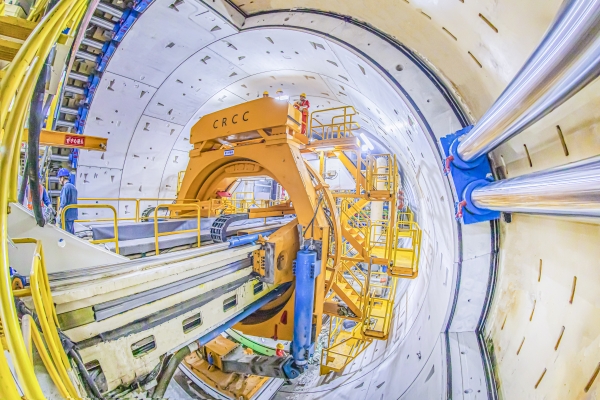The Shenjiang 1 tunnel boring machine (TBM) successfully completed a 3,590-meter excavation mission on Monday, marking a significant milestone in the construction of the Pearl River Estuary Tunnel, part of the Shenzhen-Jiangmen Railway project.
The tunnel, built by China Railway’s 14th Bureau Group, a subsidiary of China Railway Construction Corporation Limited, reached a depth of 106 meters below the seabed in the Pearl River Estuary, setting a new record for the deepest underwater high-speed rail tunnel.

The Shenjiang 1 tunnel boring machine operates 106 meters below the seabed. [Photo/sasac.gov.cn]
The Pearl River Estuary Tunnel, on a crucial 13.69-kilometer segment of the Shenzhen-Jiangmen Railway in Guangdong province, has been bored using a combination of mining and shield tunneling techniques to navigate complex geological conditions.
The shield machine, with a cutting diameter of 13.42 meters, progressed 3.59 kilometers from Dongguan to Guangzhou’s Nansha district, during which it traversed 13 different geological strata and five complex geological formations in unprecedented conditions.
The tunnel’s deepest point, 106 meters beneath the estuary, subjected the Shenjiang 1 to extreme water and soil pressures. The machine can withstand water and soil pressures of up to 10.6 bar, which is equivalent to a pressure of 10.6 kilograms on an area the size of a fingernail.
The Shenjiang 1 was designed for the task by incorporating advanced technologies such as a tool wear monitoring system, HSP advanced geological forecasting and automated pipeline welding robots. The project team conducted research on seven key technological innovations, including quick tool replacement for long-distance hard rock excavation under ultra-high water pressure, and in-situ disassembly of the TBM in confined spaces beneath the seabed. These innovations ensured continuous, stable and safe TBM operation in complex geological conditions.
The Shenzhen-Jiangmen Railway is a crucial part of China’s high-speed railway network along the coastal corridor. Once completed, the line will significantly enhance regional connectivity, allowing travel from Shenzhen’s Qianhai Free Trade Zone to Guangzhou’s Nansha Free Trade Zone in just 30 minutes and boosting economic development in the Guangdong-Hong Kong-Macao Greater Bay Area.
(Executive editor: Zhu Zeya)